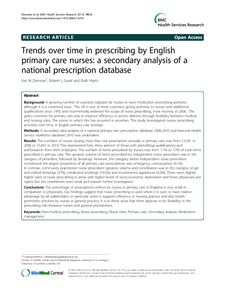Drennan, VM; Grant, RL; Harris, R
(2014)
Trends over time in prescribing by English primary care nurses: a secondary analysis of a national prescription database.
BMC Health Services Research, 14 (54).
ISSN 1472-6963
https://doi.org/10.1186/1472-6963-14-54
SGUL Authors: Drennan, Vari MacDougal
![[img]](https://openaccess.sgul.ac.uk/104772/1.hassmallThumbnailVersion/1472-6963-14-54.pdf)  Preview |
|
["document_typename_application/pdf; charset=binary" not defined]
Published Version
Download (363kB)
| Preview
|
Abstract
BACKGROUND: A growing number of countries legislate for nurses to have medication prescribing authority although it is a contested issue. The UK is one of these countries, giving authority to nurses with additional qualifications since 1992 and incrementally widened the scope of nurse prescribing, most recently in 2006. The policy intention for primary care was to improve efficiency in service delivery through flexibility between medical and nursing roles. The extent to which this has occurred is uncertain. This study investigated nurses prescribing activities, over time, in English primary care settings.
METHODS: A secondary data analysis of a national primary care prescription database 2006-2010 and National Health Service workforce database 2010 was undertaken.
RESULTS: The numbers of nurses issuing more than one prescription annually in primary care rose from 13,391 in 2006 to 15,841 in 2010. This represented forty three percent of those with prescribing qualifications and authorisation from their employers. The number of items prescribed by nurses rose from 1.1% to 1.5% of total items prescribed in primary care. The greatest volume of items prescribed by independent nurse prescribers was in the category of penicillins, followed by dressings. However, the category where independent nurse prescribers contributed the largest proportion of all primary care prescriptions was emergency contraception (9.1%). In contrast, community practitioner nurse prescribers' greatest volume and contribution was in the category of gel and colloid dressings (27%), medicated stockings (14.5%) and incontinence appliances (4.2%). There were slightly higher rates of nurse prescribing in areas with higher levels of socio-economic deprivation and fewer physicians per capita, but the correlations were weak and warrant further investigation.
CONCLUSIONS: The percentage of prescriptions written by nurses in primary care in England is very small in comparison to physicians. Our findings suggest that nurse prescribing is used where it is seen to have relative advantage by all stakeholders, in particular when it supports efficiency in nursing practice and also health promotion activities by nurses in general practice. It is in these areas that there appears to be flexibility in the prescribing role between nurses and general practitioners.
Statistics
Item downloaded times since 05 Mar 2014.
Actions (login required)
 |
Edit Item |




